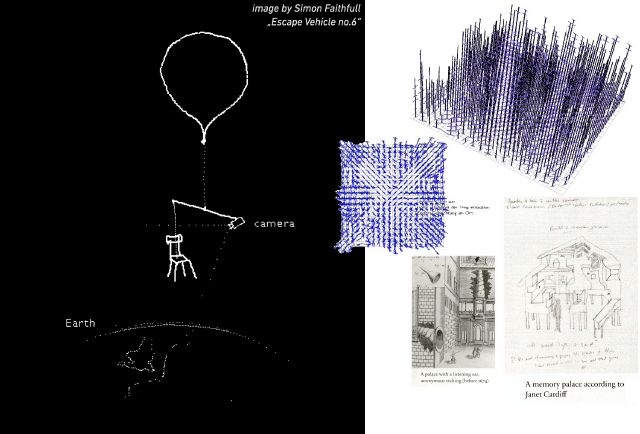The map is not the territory it represents, but, if correct, it has a similar structure to the territory, which accounts for its usefulness. — Alfred Korzybski, Science and Sanity, p. 58.
Maps and territories contrast two manifestations of space: there are inner mental maps that are subject to the logic of our brain and the functioning of neurons. And there is a territory outside. It shows causalities with which we live and act unquestioned and validate with formulas. Possibility spaces are a rather new promise. The term comes from mathematics and describes all states of a system, which in our case is described by sensor data and spatial coordinates. The humanities have assigned great power and vision to these spaces: described by Foucault as utopias, virtual spaces are now places of rich life under entirely new conditions. The project deals with questions of craftsmanship in working with space with the help of sensors as well as with the technological history and constitution of space. In the end, our corporality is and remains the central point of orientation and the measure of reference. It will also be examined how philosophical questions, which in the end ask how utopias become visions and how these can be brought into a non-violent relation and strategy to and in the present.
The project expects the participants to conceive and elaborate a self-defined work, but also offers numerous literature and excursions on the topic.
Part of the project is a field trip to Schieferpark /Thüringen as an intensive working retreat in early June. The specialized modules of the professorship are recommended for technical assistance.
Karten und Territoren stellen zwei Raummanifestationen gegenüber: da gibt es innere mentale Räume, die der Logik unseres Gehirns und der Funktionsweise der Neuronen unterliegen. Und es gibt ein Territorium draussen, das Kausalitäten aufweist, mit denen wir ungefragt leben und handeln. Möglichkeitsräume sind ein eher neues Versprechen. Der Term kommt aus der Mathematik und beschreibt alle Zustände eines Systems, das in unserem Fall durch Sensordaten und Raumkoordinaten beschrieben wird. Die Geistesgeschichte weisst diesen Räumen eine große Kraft und Vision zu: von Foucault als Utopien beschrieben, sind virtuelle Räume mittlerweile Orte von reichhaltigem Leben unter ganz neuen Bedingungen.
Im Projekt geht es sowohl um handwerkliche Fragen im Arbeiten mit Raum unter zur Hilfenahme von Sensoren wie auch um die technologische Geschichte und Verfaßtheit von Raum. Dabei ist und bleibt letztendlich unsere Körperlichkeit zentraler Orientierungspunkt und Maßgabe der Referenz. Es soll auch untersucht werden, wie weltanschauliche Fragestellungen, die letztendlich danach fragen, wie aus Utopien Visionen werden und wie diese in eine gewaltfreie Relation und Strategie zur und in die Gegenwart gebracht werden können.
Das Projekt erwartet von den Teilnehmern die Konzeption und Ausarbeitung eines selbstdefinierten Werkes, bietet aber auch zahlreiche Literatur und Exkurse zum Thema.
Bestandteil des Projektes ist eine Exkursion in den Schieferpark als intensivem Arbeitsretreat Anfang Juni. Empfohlen werden die Fachmodule der Professur zur technischen Hilfestellung.
Fach courses
Materials:
Books:
- Gregory Bateson: Steps to an Ecology of Mind: Collected Essays in Anthropology, Psychiatry, Evolution, and Epistemology
- Alfred Korzybski: Science and Sanity – An Introduction to Non-Aristotelian Systems and General Semantics
- Die Heterotopien. Der utopische Körper: Zwei Radiovorträge by Michel Foucault ISBN 978-3518296714
- Michel Foucault. Of Other Spaces: Utopias and Heterotopias in english
- Raumwissenschaften Hg.: Stefan Günzel ISBN 978-3-518-29491-8
- Program Earth by Jennifer Gabrys ISBN 978-0-8166-9314-6
- How to Do Things with Sensors by Jennifer Gabrys ISBN 978-1-5179-0831-7
- Sensing Machines by Chris Salter ISBN 9780262046602
- See yourself Sensing by Madeline Schwartzman ISBN 1907317295
- The Architecture Machine by Nicolas Negroponte ISBN 978-0262640107
- Frederick J. Kieseler: Endless Space ISBN 3-7757-1047-7
- Hans Baumer: Sferics ISBN 9783498004873
- Douglas Davies: Vom Experiment zur Idee. Die Kunst des 20. Jh im Zeichen von Wissenschaft und Technologie ISBN 9783770108114
- Uexkülls Stroll through the worlds of animals and men
- Georges Canguilhelm Über Maurice Halbwachs - Henning Schmidgen Das Problem der Umwelt ISBN 978-3-7518-9007-6
Traditional Artists:
- Ocean Earth by Peter Weibel and Peter Fend
- Website Dennis Oppenheim
- Memory Palace Documentation by Janet Cardiff and George Bures Miller
- Paul McCarthy @ WhitneyMuseum
- Lightning Field by Walter de Maria
- Alvin Luciers "Sferics" Installation
- Ana Rewakowicz
- Simon Faithfull
Digital Artists/Designers:
- Forensic Architecture
- Ricardo Dominguez
- Luc Courchesne
- David Bowen
- Gravicells by Mikami/Ichikawa, Videodocumentation
- Edwin von der Heide: Sparks
- Raphael Lozano-Hemmer
- Yolande Harris: Satellite Sounders
- Home of the Brain by Monika Fleischmann
- Overskopia by Saurabh Datta
- Gerhard Eckel, VR Artwork from 2000
Topics for Presentations/Lectures to prepare (by students):
* on Hans Baumers Sferics * on Peter Fends Ocean Earth * Dennis Oppenheims oevre * Dew Collectors * Ana Rewakowicz works * "Video Place" by Myron Krueger * "The map is not the territory" * VR as a "map of a territory" * KI as a new form of map
other Materials:
- Alfred Korzybski, on Science and Sanity: An Introduction to Non-Aristotelian Systems and General Semantics
- Menimagerie Website
- Sferics bei Wikipedia
- Ecological Niche and their spaces
- Materials from Inge Hinterwaldner Art & Technology Bewegungen in Amerika
- Lutz Dambeck on Technology and Seek (Installation by Niclolas Negroponte)
- Video documentation on the revival of "Seek"
- DAOWO
- Transborder Immigrant Tool by Ricardo Dominguez
- ETOYS Digital Hijack (1996)
Students:
- N.N.
- N.N.
